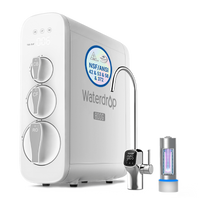If you read the news a lot, you must have ever come across reports of PFAS(per- and polyfluoroalkyl substances) chemicals found in wells, rivers, landfills, or groundwater somewhere in the US or elsewhere in other countries.
According to a
recent report by the Department of Environmental Protection,one-third of 114 Pennsylvania public water systems were found to contain the toxic PFAS chemicals, although none of them exceed the
EPA’s upper limit of 70 PPM.
In
another report, the PFAS chemicals are detected in groundwater at nearly 60 closed landfills in Minnesota, at amounts higher than the state’s acceptable level for safe drinking water.
Although earlier in this year when Biden started to take office, the
EPA pledged to regulate PFAS in drinking water, and they are taking actions to address PFAS in water-- there is still no federal cleanup standard until now.
There are also voices from scientists indicating that the EPA’s health advisory level of 70 PPM for PFAS is not low enough to protect public health.
Based on those facts, some states including North Carolina, Pennsylvania, Rhode Island, and Wisconsin started the process to regulate the chemicals and set PFAS cleanup standards themselves.
PFAS regulation in drinking water has already become a critical issue of environmental and public health concern nowadays in the United States, which not only needs the government but every citizen to take action right now.
What is PFAS?
PFAS, which is short for Per- and Polyfluorinated substances, is a group of human-made chemicals resistant to water, oil and heat. These chemicals have been widely used in various industries and commercial applications since companies manufactured them by the mid-twentieth century.
PFAS chemicals are commonly used in life and exist in products like water-resistant clothing and shoes, non-stick cookware, stain-resistant carpeting, food packaging, polishes, paints, etc.
How can PFAS affect people’s health?
With characteristics that do not break down easily, the PFAS are known as the “forever chemicals ” that would persist and accumulate in our environment, gradually go in and build up into human bodies, causing potential risks to our health.
According to the EPA, exposure to certain PFAS compounds can increase cholesterol, impact infant birth weights, affect our immune system, lead to diseases like cancer, thyroid hormone disruption, etc.
How to remove PFAS in water with home water treatment?
Drinking water from PFAS contaminated water supplies is one of the most common ways to get exposed to the chemicals.
Although the EPA and the states are taking actions to regulate and clean up PFAS chemicals from the drinking water and the environment, it is a great challenge and may take years and even decades of efforts to make progress.
How to protect ourselves from PFAS chemicals in drinking water?
Fortunately, many studies have shown that point-of-use filters with certain technologies can also effectively remove PFAS, making it possible for people to remove PFAS from their home water supply.
Activated Carbon Treatment
Activated carbon treatment could work well for reducing PFAS in water. It is commonly used to adsorb natural organic compounds, taste and odor compounds, and synthetic organic chemicals in drinking water treatment systems.
If you check the water filter materials, you can easily find the activated carbon in
refrigerator filters,
faucet-mounted filters,
pitcher filters, and other filtration systems. According to the
studies by Duke University and N.C. State University, the activated carbon filters could remove 73 percent of PFAS contaminants on average.
Yet, they also found the activated-carbon filters’ effectiveness was inconsistent and unpredictable as the test result for each test varies a lot. The activated carbon filter is only effective in removing longer-chain PFAS but not the shorter-chain PFAS.
High-pressure Membranes
High-pressure membranes like reverse osmosis use a partially permeable membrane to separate ions, unwanted molecules and larger particles, considered the most effective technologies to reduce PFAS in water.
Researchers from Duke University and N.C. State University tested 76 home water filtration systems for their efficiency in reducing PFAS. The study found that reverse osmosis works the best compared to other often used filter systems on the market, like refrigerator filter, pitcher style filter, whole-house filter, etc.
The RO system could reduce GenX and other PFAS by 94 percent or more. The
reverse osmosis membranes contain pores of 0.0001 microns that are only big enough to allow the passage of water molecules while blocking the PFAS and other contaminants.
Takeaway:
There is still a long way to go for the final regulation and removal of those toxic chemicals from our living environment and drinking water at a federal and states level. As a citizen, it is important to know how to avoid getting exposed to those chemicals—— test your home drinking water regularly, and take solutions to safeguard your home drinking water from these worrying toxic chemicals.
Reference:








































































